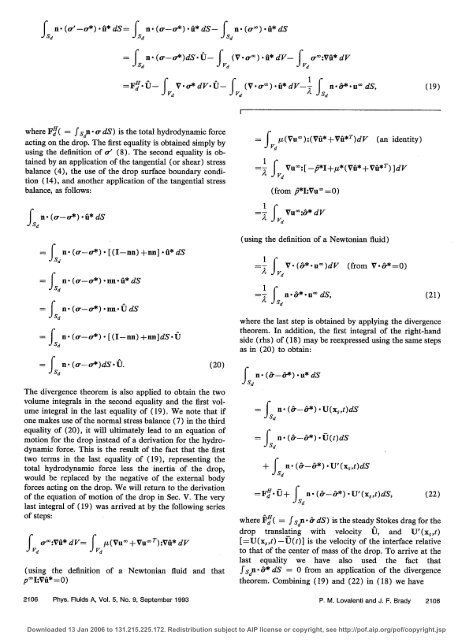The force on a bubble, drop, or particle in arbitrary time-dependent ...
The force on a bubble, drop, or particle in arbitrary time-dependent ...
The force on a bubble, drop, or particle in arbitrary time-dependent ...
You also want an ePaper? Increase the reach of your titles
YUMPU automatically turns print PDFs into web optimized ePapers that Google loves.
=fSd<br />
L -(r' d ,) J d d Tn-(,-o* Pd-d n . (o,) .fV*dS<br />
. f~dn-(, ,)dS J - d ,~ J( d-d a~:Vfi* dV<br />
=F'f- vV--*dV.UJ- Fv (V-a)- V n O * u- dS,<br />
(19)<br />
where F'IV( = f Sdn a- dS) is the total hydrodynamic <str<strong>on</strong>g>f<strong>or</strong>ce</str<strong>on</strong>g><br />
act<strong>in</strong>g <strong>on</strong> the <strong>drop</strong>. <str<strong>on</strong>g>The</str<strong>on</strong>g> first equality is obta<strong>in</strong>ed simply by<br />
us<strong>in</strong>g the def<strong>in</strong>iti<strong>on</strong> of oa' (8). <str<strong>on</strong>g>The</str<strong>on</strong>g> sec<strong>on</strong>d equality is obta<strong>in</strong>ed<br />
by an applicati<strong>on</strong> of the tangential (<strong>or</strong> shear) stress<br />
balance (4), the use of the <strong>drop</strong> surface boundary c<strong>on</strong>diti<strong>on</strong><br />
(14), and another applicati<strong>on</strong> of the tangential stress<br />
balance, as follows:<br />
J-d n. (ju-u*) -fi* dS<br />
fd T tV-:Vt*ViT)V(an identity)<br />
=;~ .f~ VUcw:[_fi*l+lM*(Vfi*+Vfi* T )]IdV<br />
(from fi*I:Vu - = 0)<br />
=;T Vd Vu~:&* dV<br />
fSd n.(o<br />
u*) . [(I-nn)+nn]-uf*dS<br />
(us<strong>in</strong>g the def<strong>in</strong>iti<strong>on</strong> of a Newt<strong>on</strong>ian fluid)<br />
=- f V.(a*.u )dV (from V.O*=0)<br />
= Sd<br />
-r n*(o-o-a*)nn*U dS<br />
= fSd n (a- o*). [(I-nn) +nn-dS<br />
= n -(<strong>or</strong>- a*)dSU. (20)<br />
<str<strong>on</strong>g>The</str<strong>on</strong>g> divergence the<strong>or</strong>em is also applied to obta<strong>in</strong> the two<br />
volume <strong>in</strong>tegrals <strong>in</strong> the sec<strong>on</strong>d equality and the first volume<br />
<strong>in</strong>tegral <strong>in</strong> the last equality of (19). We note that if<br />
<strong>on</strong>e makes use of the n<strong>or</strong>mal stress balance (7) <strong>in</strong> the third<br />
equality of (20), it will ultimately lead to an equati<strong>on</strong> of<br />
moti<strong>on</strong> f<strong>or</strong> the <strong>drop</strong> <strong>in</strong>stead of a derivati<strong>on</strong> f<strong>or</strong> the hydrodynamic<br />
<str<strong>on</strong>g>f<strong>or</strong>ce</str<strong>on</strong>g>. This is the result of the fact that the first<br />
two terms <strong>in</strong> the last equality of (19), represent<strong>in</strong>g the<br />
total hydrodynamic <str<strong>on</strong>g>f<strong>or</strong>ce</str<strong>on</strong>g> less the <strong>in</strong>ertia of the <strong>drop</strong>,<br />
would be replaced by the negative of the external body<br />
<str<strong>on</strong>g>f<strong>or</strong>ce</str<strong>on</strong>g>s act<strong>in</strong>g <strong>on</strong> the <strong>drop</strong>. We will return to the derivati<strong>on</strong><br />
of the equati<strong>on</strong> of moti<strong>on</strong> of the <strong>drop</strong> <strong>in</strong> Sec. V. <str<strong>on</strong>g>The</str<strong>on</strong>g> very<br />
last <strong>in</strong>tegral of (19) was arrived at by the follow<strong>in</strong>g series<br />
of steps:<br />
f<br />
&r:Vfi* d V= Vd f(VU<br />
+VuwT):Vfi* d<br />
(us<strong>in</strong>g the def<strong>in</strong>iti<strong>on</strong> of a Newt<strong>on</strong>ian fluid and that<br />
p ,I:Vfi* =O)<br />
2106 Phys. Fluids A, Vol. 5, No. 9, September 1993<br />
1<br />
A fsd n d * u- dS, (21)<br />
where the last step is obta<strong>in</strong>ed by apply<strong>in</strong>g the divergence<br />
the<strong>or</strong>em. In additi<strong>on</strong>, the first <strong>in</strong>tegral of the right-hand<br />
side (rhs) of ( 18) may be reexpressed us<strong>in</strong>g the same steps<br />
as <strong>in</strong> (20) to obta<strong>in</strong>:<br />
fS n (f&-&*) .u*dS<br />
=fX n (&o v) U(x,,t)dS<br />
n -( &*) *U(t)dS<br />
+ .f n.(&-e)-U'(x,,t)dS<br />
F'"J fsdn - &- &) -U' nextt) dS, (22)<br />
where F'H( = f sdn * C dS) is the steady Stokes drag f<strong>or</strong> the<br />
<strong>drop</strong> translat<strong>in</strong>g with velocity U, and U' nextt)<br />
[=U(xst) -U(t)] is the velocity of the <strong>in</strong>terface relative<br />
to that of the center of mass of the <strong>drop</strong>. To arrive at the<br />
last equality we have also used the fact that<br />
fsdn -&* dS = 0 from an applicati<strong>on</strong> of the divergence<br />
the<strong>or</strong>em. Comb<strong>in</strong><strong>in</strong>g (19) and (22) <strong>in</strong> (18) we have<br />
P. M. Lovalenti and J. F. Brady 2106<br />
Downloaded 13 Jan 2006 to 131.215.225.172. Redistributi<strong>on</strong> subject to AIP license <strong>or</strong> copyright, see http://pof.aip.<strong>or</strong>g/pof/copyright.jsp
















